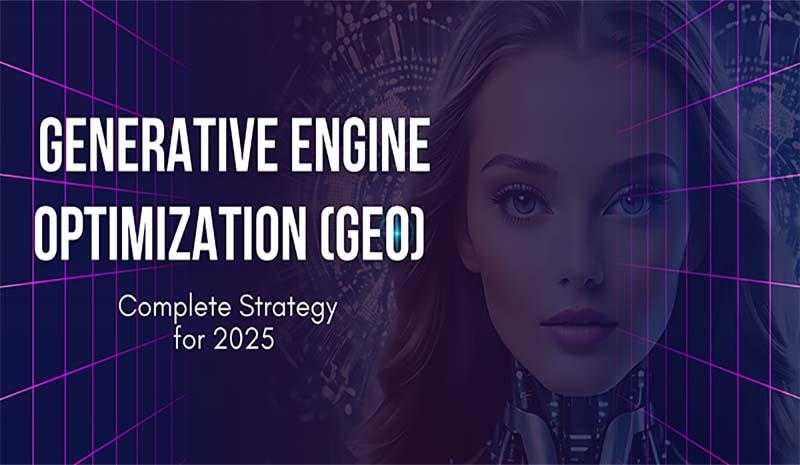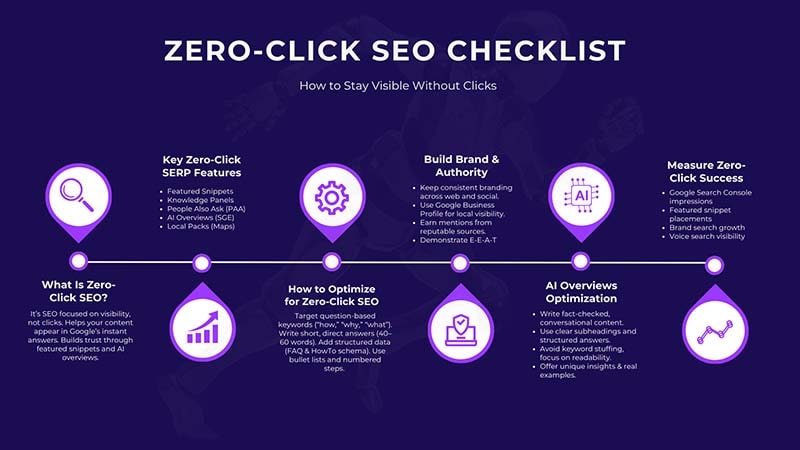What Is GEO & Why It Matters
Generative Engine Optimization (GEO) is a method of content optimization to make it get referred to citations, or used directly by generative AI like ChatGPT, Google Gemini, Perplexity, Copilot, and Claude. In contrast to conventional SEO that aims at elevating web pages to the highest positions in Google’s organic search results, GEO serves to let your brand and content be seen and picked out by the AI tools when they answer.
This will be important in 2025 due to the drastic change in user behavior. Rather than going through several links, users now want instant, conversational, and context-aware answers supplied by AI. Brands that do not adapt will experience a steep fall in organic traffic whereas those that take command of GEO will get the lion’s share of brand visibility and authority.
Why GEO is critical today
- New AI platforms are the “next front door” to information.
- Citing increases both credibility and brand recall.
- Zero-click searches make brand presence more important than clicks.
- GEO provides a competitive advantage against just SEO-only traditional strategies.
GEO vs Traditional SEO: Key Differences
The main difference between traditional SEO and GEO is that they have the same base but differ in goals and ways of implementation. SEO has the same significance but has lost its leading role in the world of generative engines.
| Feature | Traditional SEO | Generative Engine Optimization (GEO) |
| Focus | Rankings in SERPs, organic traffic | Citations in AI answers, brand inclusion in generated responses |
| Content Style | Keyword-oriented, structured for algorithms | Conversational, semantically rich, optimized for AI summarization |
| Technical Needs | Crawlability, speed, mobile-friendliness | Schema, factual clarity, structured data for AI parsing |
| Off-Page Signals | Backlinks, DA, social shares | Mentions in authoritative sources, UGC, community citations |
| Metrics | Rankings, CTR, traffic | AI citations, share of voice, sentiment, AI-featured visibility |
Simply speaking: SEO helps your website land on the first page of Google and GEO ensures that your website appears in the answer boxes that users can directly see.
Major Generative Engines & Their Behaviors
Every AI has different methods of gathering, filtering and displaying data. If you want to achieve the best result with GEO you have to realize these characteristics.
- ChatGPT (OpenAI): Likes content that is organized, comes from a reliable source and is rich in context. When browsing is turned on, it gives references and prefers easy-to-understand explanations.
- Google Gemini & AI Overviews: Relies on the factors of trust, freshness, and structured data for ranking. The sources have to be accurate and credible, most of the time they are from well-known publishers.
- Perplexity AI: Most citation-heavy. The sources are very conspicuous in the references it provides, thus off-page mentions become very important. UGC, forums, and expert articles are the ones that get usually cited.
- Microsoft Copilot: Uses data from Bing’s search to work, so schema, technical clarity, and a strong domain authority are the most important factors.
- Claude (Anthropic): Concentrates on exactness of facts, subtlety, and clearness of the text. It quite often considers the well-structured, contextually profound writing.
Hint: Adjust your content to fit each engine’s advantages. For instance, if Perplexity is your audience, concentrate on third-party mentions; for Google Gemini emphasis on schema markup and authoritative linking.
Core Pillars of a GEO Strategy in 2025
Core GEO Pillars
- Authority & Earned Mentions: Secure mentions in reputable publications. Build UGC engagement on forums like Reddit, Quora, and niche communities. Position your brand as a go-to expert cited in industry news.
- Content Structure & Semantic Clarity: Use headers, FAQs, summaries, and comparison tables. Write in conversational tone with clear definitions and explanations. Break down complex concepts so AI can easily parse them.
- Search Intent Alignment: Focus on questions, how-tos, and comparisons rather than keywords. Address user intent directly: “What is…”, “How to…”, “X vs Y”. Provide short summaries followed by in-depth analysis.
- Technical Foundations: Keep websites that are crawlable, mobile-friendly, and fast. Implement schema markup (FAQ, How-To, Local, Article). Make sure there are minimal JavaScript obstacles for AI crawlers.
- Freshness & Content Decay Management: Regularly update evergreen content with new data. Check the older articles for accuracy and replace the outdated statistics. Keep track of the decline in the visibility of AI citations.
- User & Community Signals: Invite the community to join discussions, submit reviews, and provide feedback. Use the power of micro-influencers and thought leaders to get mentions. Increase your presence on Q&A platforms from where AI answers are taken.
Tactical GEO Steps: How to Implement
Developing a global (GEO) strategy is a process that necessitates the use of a schematic, stepwise approach. To maintain your brand being referenced and recognized within the AI systems, you would need more than just a content update, you would require a well-coordinated daily workflow. Such a workflow ensures that your brand is not only visible but also indigenously cited in generative AI platforms. The following are the key phases of a GEO strategy. The stages are outlined in brief and provide practical activities that can be done instantly.
Step 1 – GEO Audit & Benchmarking
First of all, you need to know how visible you are at present. Find out the places in AI answers where your brand is mentioned, as well as where your competitors are receiving more mentions. This check-up will reveal the areas for improvement and opportunities for advancement.
- Evaluation of the references and mentions of the AI across the platforms ChatGPT, Gemini, and Perplexity.
- Finding the citations of competitors that you are not aware of.
- Conducting a technical SEO audit: site speed, indexability, and schema markup health.
Step 2 – Content Mapping & Planning
First, you have to find the gaps; Then you can link your content strategy with user intent and AI-driven queries. Organize content that solves genuine questions and make sure the format serves AI summarization.
- Connect high-intent queries such as “best tools,” “X vs Y,” and “how to” searches.
- Give the first place to FAQ-style and comparison content.
- Create a publishing calendar to include both evergreen and trendy topics.
Step 3 – Content Creation & Optimization
We are now figuring out how to make content that is for AI and still user-friendly. One of your objectives is to give clear, authoritative, and well-organized data that can be easily employed by AI in their answers.
- Make use of H2/H3 headings, bullet points, and brief summaries.
- Include trustworthy sources, expert opinions, and numbers.
- Use a conversational and authoritative tone.
Step 4 – Technical GEO Optimization
Even great content that is not visible from a technical point of view will not be cited. AI engines need clean data and well-structured signals to understand and classify your content.
- Use schema markup (FAQ, How-To, Article, Local Business).
- Make the site faster and more mobile-friendly.
- Ensure that the URLs are short, logical, and crawlable by search engines.
Step 5 – Off-Page Authority Building
AI systems use the whole world web to determine the importance of mentions. Establishing your authority outside your site means that your brand will be acknowledged as reliable and cited by AI search engines.
- Get published as a guest author and an expert contributor in niche publications.
- Participate in communities such as Reddit, Quora, and LinkedIn groups.
- Keep an eye on and track mentions in directories and industry news outlets.
Step 6 – Monitoring & Iteration
GEO is not a “set and forget” type of thing. AI models and search patterns are constantly changing and maturing, which means that continual oversight and improvement are needed.
- Measure the frequency of your brand mentions in AI-generated responses.
- Keep an eye on the decline of your content and update the old ones.
- Regularly check the volume of your “share of AI voice” in relation to your rivals.
Measuring Success & KPIs for GEO
One important aspect for you to consider is that when you evaluate the effectiveness of your GEO strategy in 2025, you should take a different approach from the traditional SEO practice. The main emphasis should not be put on just the rankings and the amount of website traffic, but rather the companies should assess the extent to which their brand is being mentioned in AI-generated solutions. If your competitors are more frequently quoted by ChatGPT, Gemini, or Perplexity than you, then there is a void of authority that you need to address.
One more key figure to consider is branded search increment, users looking for your company after seeing you in AI summaries. This is the direct impact of generative visibility on brand awareness. While this is happening, it is also very important to check the correctness and timeliness of your content, as pages that are obsolete or contain errors will have a lower ranking in AI search results. Lastly, monitoring your “share of AI voice” in relation to rivals is the only way you can know your position in this changing market.
Common Mistakes & Risk Management
Brands frequently use GEO as targeting, but they continue to apply traditional SEO techniques that are not very effective and limit the ways in which their visibility is increased. You should not fall into these scenarios:
- ❌ Keyword stuffing: AIs prefer one point made clearly without using the same word again and again.
- ❌ Incorrect or obsolete information: leads to loss of the customer’s trust and a decrease in the number of your local citations.
- ❌ Disregarding technical issues: web pages hidden with the help of JavaScript are often invisible to search engine crawlers.
- ❌ Merely depending on backlinks: the number of mentions, citations, and your reputation is important than link building.
- ❌ Not using AI for SEO monitoring: if you do not measure it, you cannot make it better.
Pro Tip: The main focus should be on the company being correct, trustworthy, and having a well-structured and clear presentation of the information – these are the most AI-friendly signals.
Future Trends & How to Stay Ahead
GEO will be more vibrant, multimodal, and context-driven in the future. Businesses need to be forward-thinking rather than reactive.
Multimodal GEO: AI will not only be able to understand but also create images, videos, and voice inputs; smoothly managing different kinds of information.
Hyper-Personalization: The AI will adapt the information given to the user based on the user’s behavior, which will make local GEO and contextual content indispensable.
Rising Number of AI Platforms: Apart from ChatGPT and Gemini, there will be more AI engines for specific purposes, such as legal AI and medical AI, that will require customized GEO.
Changes in Regulations: The content that is accurate, trustworthy, and thoroughly checked will be given prominence as governments introduce laws against misinformation.
AI-Tracking Instruments: The use of automated systems for the discovery of AI mentions will be a norm in the future.


